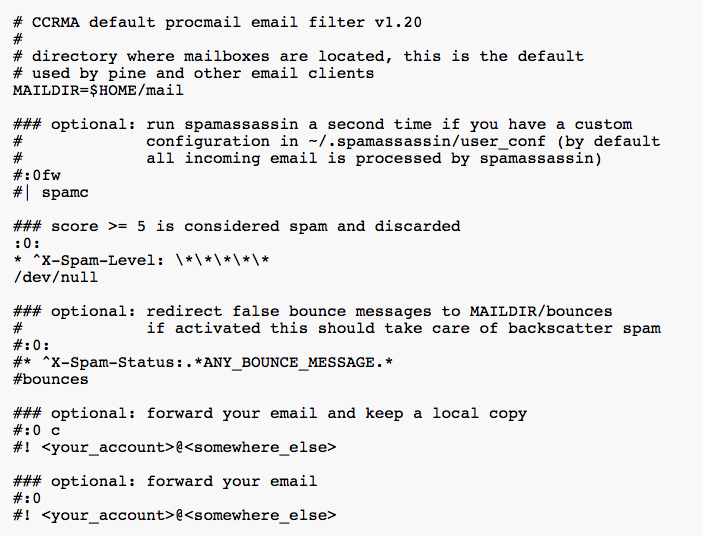
CCRMA Documentation links: index contents overview rooms account staff about
(contents of this file: links to each section)

Welcome to CCRMA’s Spam fighter homepage. Having a “Spam Free” inbox is a requires vigilence on everyone’s part. In the text below, we’ll describe what you can do to minimize your Spam.
All incoming email to CCRMA is filtered through two programs. Spam is
handled by Spamassassin and
virus detection is handled through ClamAV. All emails are piped
automatically through these two programs before they
reach your Inbox. Spamassassin uses many tests to assign a score to all
emails. If the score is high enough, the email is rejected to the sender
and you will never see it. If an email passes that first hurdle it is
delivered to your mailbox through a program called
procmail. Your account already contains a
procmail configuration file (.procmailrc, located in the
highest level of your CCRMA home directory) that discards emails with a
Spamassassin score of 5 or more. The rules that Spamassassin uses to
rate email messages are updated regularly.
You can further tune what it does by following the instructions below.
.procmailrcThe .procmailrc file is located in the top level of your
home directory and is a ‘hidden’ file (because of the dot in the file
name). You can check if it is there by typing at the terminal command
line:
~> ls -a | grep procmail
.procmailrcYou can view the file by typing (from the top level of your home directory):
~> less .procmailrcIf you are a new user and still have not modified this file you should see this:

This file is key in your Spam control effort. True, it’s a bit technical, but taking a moment to understand what is happening here will not only keep unwanted emails from appearing in your Inbox, but will allow you to further configure Spamassassin if you wish, and to set email forwarding to another email account.
.procmailrc
Breakdown (looking at each section)Each section of this file serves an important purpose. Note that any
line that begins with a ‘#’ is ‘commented out’ and will not
be read by the procmail system. If the line has ‘###’, it
means that these are text comments and not code, and should be left
alone, and not removed. Further, almost every line in the default
.procmailrc file is already commented out, meaning that
only two parts are operational by default:
Sets the default mail directory in your home directory. This is the same directory that we recommend for IMAP:
MAILDIR=$HOME/mailSets your local threshold for spam messages that are to be discarded
(or more accurately: sent to /dev/null, aka. permanently
deleted). Remember, that Spamassassin has already rejected messages
which are most certainly Spam ( >= score 10), but this setting allows
you to delete messages of a lower score. The default is 5 (or
‘\*\*\*\*\*’ which stands for 5 stars). You can raise or
lower the threshold by editing this section of
.procmailrc:
// score >= 5 is considered spam and discarded
:0:
* ^X-Spam-Level: \*\*\*\*\*
/dev/nullThis configuration permits procmail to compare portions
of each email header received against this rule containing
\*\*\*\*\*. See a short explaination of email headers below
[[Spam_Control_at_CCRMA#Email_Headers_and_Spamassassin | Email Headers
and Spamassassin]].
Configuring SpamAssassin on a per user basis requires some advanced knowledge SpamAssassin configuration file, Writing your own rules, etc), which will be the focus of another wiki page some day. But essentially, if you feel like you want to study the SpamAssassin rules and weight them differently, emphasizing some over others, or change any other SpamAssassin options you can do it by uncommenting:
/*
optional: run spamassassin a second time if you have a custom
configuration in ~/.spamassassin/user_conf (by default
all incoming email is processed by spamassassin)
*/
:0fw
| spamcThis calls SpamAssassin (spamc) again
to reprocess your incoming messages, but this time in the context of
your account so that anything changed in your
~/.spamassassin/user_conf file will affect the outcome
(where ~/ means your home directory).
This section, if you can believe it, is a bit more obscure… Occassionally, your email address will be spoofed by a spammer (meaning: used as the ‘From:’ address) to spam a server outside of Stanford. When that email server rejects (bounces) the email, it goes back to you instead of to the originator of the message (the spammer). Often this happens in waves, in that, for a while you will be stormed by these bounce messages then things go quiet. If you find that you are having many of such emails, go ahead and uncomment this rule, and have a look in your ‘bounces’ IMAP folder to see if it is having any effect. Please come and see us if things aren’t working or if you are confused at all.
// optional: redirect false bounce messages to MAILDIR/bounces
// if activated this should take care of backscatter spam
:0:
* ^X-Spam-Status:.*ANY_BOUNCE_MESSAGE.*
bouncesTo forward email to another account, you’ll have to edit your
.procmailrc file (~/.procmailrc). Within this
file you have two choices regarding forwarding: forwarding to another
address and keeping a local copy, or forwarding to another address and
not keeping a local copy (keeping a local copy means
your email is delivered to your CCRMA account in addition to being
forwarded). If you choose to forward your email, we recommend that
unless you have a good reason to do otherwise, you should choose to
forward and not keep a local copy. In order to enable
forwarding, just uncomment (by removing the # before
:0 and your email address) whichever option you like (see
example below), but not both. The angle brackets should
also be deleted.
If you do forward your CCRMA email please keep your forwarding address current.
// optional: forward your email and keep a local copy
:0 c
! <your_account>@<somewhere_else>// optional: forward your email
:0
! <your_account>@<somewhere_else>SpamAssassin will run each email through its filter (filter rules are updated frequently to reflect new spam ‘threats’). SpamAssassin adds several lines to your email header’s. When viewing your email in your email client, you normally only see an abbreviated header which shows the ‘From:’, ‘To:’, ‘Date:’ and ‘Subject:’ lines, but you can select elect to see the full headers as well. The lines added by SpamAssassin to your (normally hidden) email header include:
X-Spam-Level:
X-Spam-Checker-Version:
X-Spam-Status:
X-Spam-Report:For now, let’s look at X-Spam-Level
since it is on this line, that you will create filter’s in your email
client. If you take a look at the header you’ll see one line that looks
like this:
X-Spam-Level: *****X-Spam-Level display’s Spam Level using the asterisk. Here, or example, for ‘Spam Level 5’ with 5 asterisks.
The idea then, is to establish email filter’s, filtering on the asterisk, in your email client which, directing these messages into more manageable folder’s or to delete the message automatically (wise for Spam Level 5 or above, where the risk of false positives is very low).
For new accounts we now add this to your .procmailrc
file which automatically deletes email messages with an
X-Spam-Level greater than 5:
// score >= 5 is considered spam
:0:
* ^X-Spam-Level: \*\*\*\*\*
/dev/nullA good idea is to filter any messages with Spam Level between 3-5 to
an email folder so you can check it periodically. That, too, can be done
with __.procmailrc__ by adding this:
// divert emails tagged with 3 or more stars to a directory
:0:
* ^X-Spam-Level: \*\*\*
spam3Since any email with a rating of >=5 asterisks has been deleted,
then any message with 3 or 4 asterisks will be routed to a directory
called ~/mail/spam3 in your home directory (remember we are
setting MAILDIR to $HOME/mail in our default procmailrc file, so spam3
will be created inside ~/mail). This directory should also be viewable
by your email client so you can check it periodically.
This page of CCRMA documentation last committed on Tue Jul 27 13:15:03 2021 -0700 by Kathleen Yuan. Stanford has a page for Digital Accessibility.